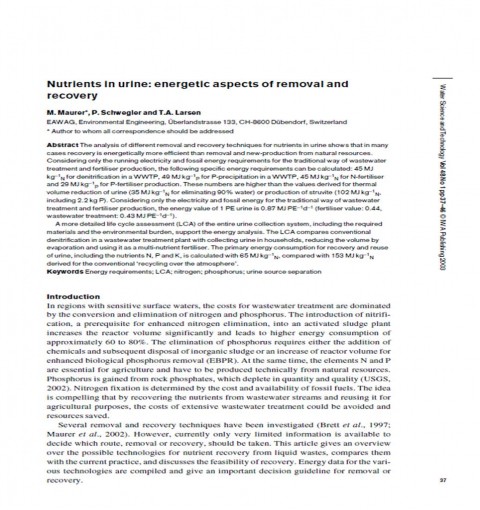Nutrients in urine: energetic aspects of removal and recovery
Maurer, M., Schwegler, P., Larsen, T. A. (2003)

Published in: 2003
Publisher:
Water Science and Technology, Vol 48, No 1, pp 37–46
Author:
Maurer, M., Schwegler, P., Larsen, T. A.
Uploaded by:
SuSanA secretariat
Partner profile:
common upload
6053 Views
58 Downloads
Content - Summary
The analysis of different removal and recovery techniques for nutrients in urine shows that in many cases recovery is energetically more efficient than removal and new-production from natural resources. Considering only the running electricity and fossil energy requirements for the traditional way of wastewater treatment and fertiliser production, the following specific energy requirements can be calculated: 45 MJ kg–1 N for denitrification in a WWTP, 49 MJ kg–1 P for P-precipitation in a WWTP, 45 MJ kg–1 N for N-fertiliser and 29 MJ kg–1 P for P-fertiliser production. These numbers are higher than the values derived for thermal volume reduction of urine (35 MJ kg–1 N for eliminating 90% water) or production of struvite (102 MJ kg–1 N, including 2.2 kg P). Considering only the electricity and fossil energy for the traditional way of wastewater treatment and fertiliser production, the energy value of 1 PE urine is 0.87 MJ PE–1d–1 (fertiliser value: 0.44, wastewater treatment: 0.43 MJ PE–1d–1). A more detailed life cycle assessment (LCA) of the entire urine collection system, including the required materials and the environmental burden, support the energy analysis. The LCA compares conventional denitrification in a wastewater treatment plant with collecting urine in households, reducing the volume by evaporation and using it as a multi-nutrient fertiliser. The primary energy consumption for recovery and reuse of urine, including the nutrients N, P and K, is calculated with 65 MJ kg–1 N, compared with 153 MJ kg–1 N derived for the conventional ‘recycling over the atmosphere’.
Additional information
(Abstract only)
Bibliographic information
Maurer, M., Schwegler, P., Larsen, T. A. (2003). Nutrients in urine: energetic aspects of removal and recovery. Water Science and Technology, Vol 48, No 1, pp 37–46
Filter tags
English Renewable energies and climate change (WG3) Urine














